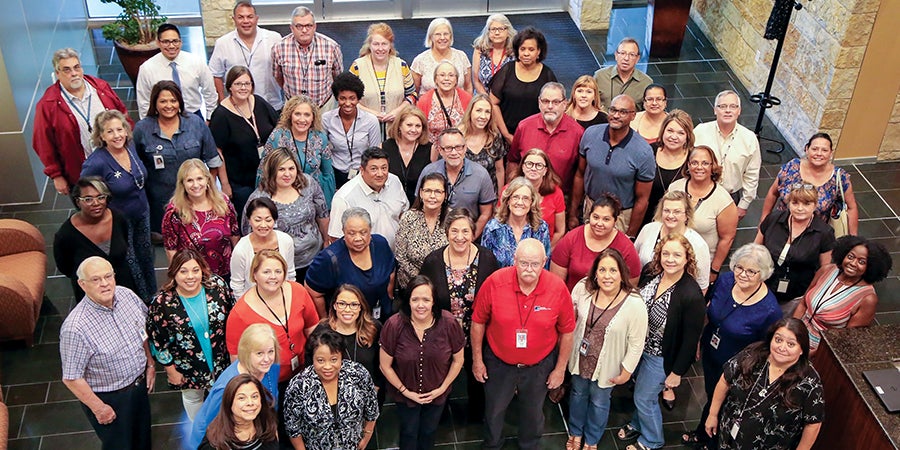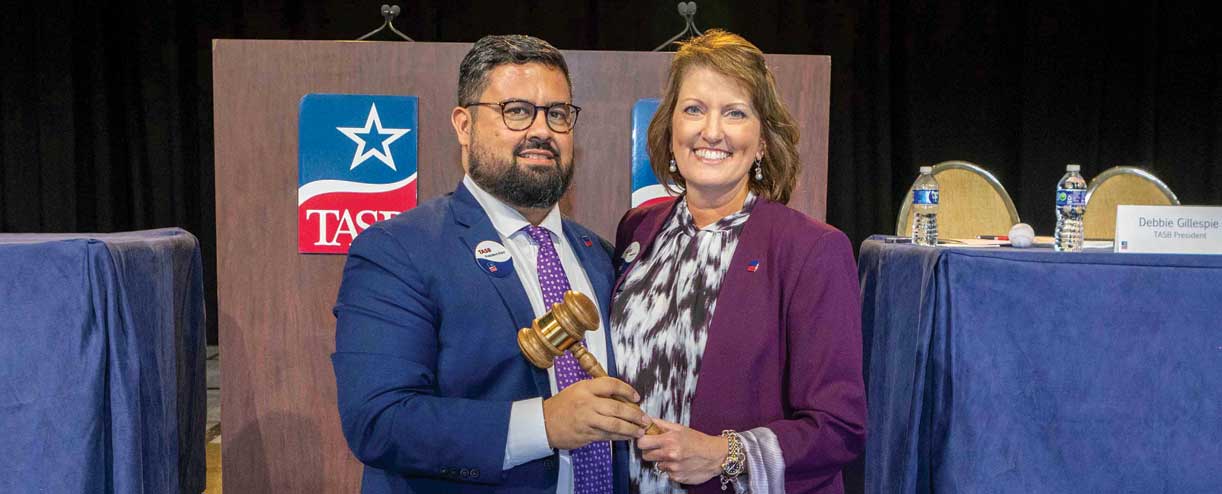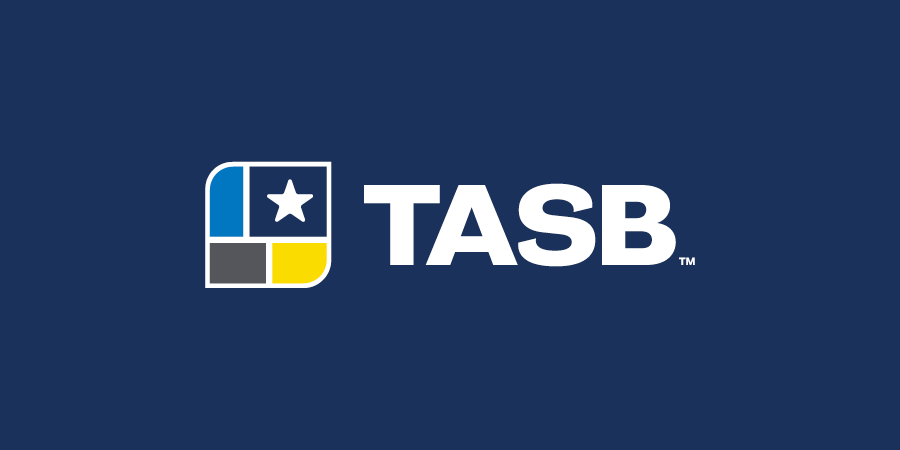TASB Risk Management Fund Celebrates 50 Years of Serving Districts
A year ago, when Lake Dallas ISD experienced a serious cybersecurity breach, it turned to the TASB Risk Management Fund for expert guidance in addressing the problem. Through the Fund’s cybersecurity coverage, the district had access to a team of experts who walked school leaders through every step of the solution, from detecting the source and magnitude of the cybersecurity incident to rebuilding files.
Wes Eversole, Lake Dallas ISD deputy superintendent and chief financial officer, said that kind of response means so much to a district when something goes wrong.
“What was amazing was that, as a district, we don’t handle something like this regularly, if at all,” said Eversole, who is also treasurer of the board that oversees the Fund. “Having access to experts in that realm right at our fingertips made a huge difference in how quickly the district was able to respond to the breach and take action. There were cybersecurity lawyers and forensic teams on calls with our administration every day for about three weeks investigating and responding to the incident.”
This year the TASB Risk Management Fund — the oldest continuously operating risk pool in Texas — is marking 50 years of helping Texas school districts cope with myriad issues, from workplace injuries to severe weather.
And while it looks very different from the effort that began in 1974, the Fund’s core mission has remained the same.
“It’s really about serving the Fund members’ needs and doing it with compassion and understanding,” said Mary Barrett, associate executive director for TASB Risk Management Services. “At the end of the day, our job is to help school districts help the students and staff that they serve.”
Today the Fund — an entity formed under the Texas Interlocal Cooperation Act administered by TASB and overseen by a 19-member board — provides a range of comprehensive coverage, including unemployment compensation, workers’ compensation, auto, liability, cybersecurity, and property programs. The Fund also offers loss prevention resources, training, and grant programs, among other services.
“Members know they can count on and rely on us for expertise,” Barrett said.
How the Fund Began
The Fund’s journey as a risk pool started with a legislative act. Senate Bill 283, which passed in 1973, required school districts to provide workers’ compensation coverage for all employees. The bill allowed for two or more political subdivisions to create a joint risk pool that could be used to provide coverage for employees.
Barrett said that traditional insurance markets weren’t interested in serving school district needs to meet the bill’s requirements. The president of TASB at the time, Will Davis, was an attorney and Austin ISD school board member. “He saw the mechanism in the law that allowed school districts to self-insure the risk and saw the wisdom of doing it together,” said Barrett. “That is how the Fund was born.”
Barrett describes the Fund as an efficient way for school districts that have similar risks and exposures to work together to protect each other. “The coverage is tailor-made for Texas school districts,” Barrett said.
On Jan. 4, 1974, the TASB Workers’ Compensation Self-Insurance Fund was created with a membership that grew quickly in the pool’s early years. In fact, it was not long after the creation of the workers’ compensation pool that TASB’s membership grew to nearly every district in the state so they could access the risk pool.
Two years later, the TASB Employee Benefits Joint Account was formed, followed by the TASB Unemployment Compensation Group Account in 1977 and the TASB Property/Casualty Joint Account in 1981.
In 1997, the four self-insurance risk pools merged to officially become the Fund, leveraging the strength of all the programs together and collaborating with available TASB expertise in human resources, business services, and school board operations to offer Fund members a comprehensive portfolio of options.
“We are all together sharing risk, and it’s not a shallow pool and that is comforting,” said Scott Campbell, superintendent of East Chambers ISD and Fund board member. “I like to think of it as we are not insurance, but we provide reassurance.”
Helping Districts
While school districts face the same risks as other industries, the cadence and challenges of the school year are unique. The Fund plays a vital role supporting Texas school districts’ operations, from providing classroom portables after a major storm or fire destroys a school building to mitigating water damage caused by ruptured pipes after a freeze.
“We replace roofs when they are damaged. We repair buses. We make sure that when employees are injured, they get the care they need and get back to school,” said Dubravka Romano, who led TASB Risk Management Services area for 35 years before retiring in 2022.
“If a school district gets sued, we are there to help them through that process. When a school district has layoffs, we diminish that impact by providing unemployment compensation benefits. It’s very rewarding work,” said Romano, now an outside adviser to the Fund’s Board of Trustees.
Unemployment compensation benefits through the Fund have been critical for districts with school funding challenges, said Barrett. These benefits can help districts with financial stability and budget predictability if they face difficult staffing decisions or changes in student enrollment.
Romano acknowledged the challenges of the work. “If someone is dealing with us, it’s because something really bad has happened, and we can help make that situation better.”
Property damage from severe weather events such as hurricanes Rita and Harvey, Winter Storm Uri, tornadoes, and record losses from hailstorms have caused hundreds of millions of dollars in damage to school districts in recent decades.
With more than $65 billion in property covered by the Fund, claims related to severe weather events are handled quickly and responsively to get districts back to serving students as soon as possible. Winter Storm Uri in February 2021, for example, resulted in $100 million in claims being paid to more than 200 member districts.
“When you have a claim, whether it’s big or small, the goal is to get that school district back to serving the kids. That’s where we come in,” Barrett said. “When there is a disruption in district operations, our job is making sure the district can move forward.”
History of Responsiveness
Weather is not the only risk to district property. Sweetwater ISD, located 40 miles west of Abilene, had a fire that destroyed a small classroom building the week before STAAR testing a couple of years ago. “Our claims adjuster was able to get remediation and portables set up on the campus so that they did not have to delay or ask for a waiver in taking the STAAR test,” Barrett said.
That history of service and responsiveness comes from having a true understanding of the needs of members — who may also be neighbors. TASB Risk Management Services employees who administer the Fund’s programs live all over the state and are part of the communities they serve.
Many of the Fund’s claims adjusters have relationships with districts that go back decades. “Our adjusters not only understand and know our members’ operations and expectations, but we also have long relationships that have been established over time.
We cherish these relationships,” said Hiawatha Franks, claims officer for TASB Risk Management Services. “The Claims department is here to serve our members to lessen the negative impact of accidents, injuries, or property damage so our member can focus on education.”
Since its inception 50 years ago, the Fund has processed 780,392 Workers’ Compensation claims or an average of more than 15,000 each year.
Franks finds great purpose in his work. “When a teacher is not able to teach in the classroom or a bus driver is injured and can’t drive his route, we know the work they do is so critical. The purpose of our work is to support continuity of education for our students.”
The Fund’s claims department receives hundreds of calls a day and services more than 40,000 calls a year. “It’s a personal connection. It’s a friendly face. It’s somebody to pick up the phone and somebody that is readily available when we need assistance,” said Eversole.
Sometimes the injury does not allow a district employee to return to the job. “A catastrophic injury, an event that irreparably changed life in that moment can require a lifetime of medical care that the Fund will provide,” Barrett said. With some life-changing injuries, the Fund also covers long-term care costs such as modifying a home to widen doorways or providing adapted vehicles.
“Over the years, we’ve added programs to respond to exactly what our members need,” Barrett said. “We even did employee benefits for a very long time.” But she said that it has been important “to have the courage to recognize when the Fund was not best positioned to meet members’ needs.”
The Employee Benefits program was discontinued after the Legislature created TRS Active Care in 2003, said Barrett. “One of the things we know is the landscape is always changing,” she said. “We need to be open to what our members will need in the future.”
Training and Resources
A main focus of the Fund’s work is to consider ways to help members mitigate risks and lessen the possibility of expensive claims.
Risk Solutions consultants spend time at districts providing training and guidance on best practices in risk mitigation, but they are also looking at what districts do well. The annual Excellence Awards recognize members for innovative risk solutions, and the Fund highlights these efforts to other members in the risk pool.
“We have a really strong risk solutions team that focuses on evaluating and scanning the horizon to make sure we understand what is coming down the pike for members in addition to responding to risks that have always been there,” Barrett said. In recognition of emerging risks for school districts, the Fund added cybersecurity coverage in 2014 and has added other programs over the years.
“Thirty years ago, when we talked about school safety, we were probably talking about playground safety. Now we all worry about active shooters and other violent acts,” said Romano.
To help districts respond to increasing campus security needs and requirements, the Fund held the School-Based Law Enforcement Summit at TASB Headquarters in Austin last November. The day-long summit was attended by about 60 representatives from member districts and was the culmination of the Fund’s first-ever residency program focused on providing members with school-based law enforcement resources and training.
The Fund will hold a conference in April at the Kalahari Resorts and Convention Center in Round Rock. The event will be an opportunity for Fund members to do a deep dive into a range of risk management topics.
The Fund has awarded millions in loss prevention and other types of grants over the years, including $500,000 in the cybersecurity grant program to more than 170 members in 2023.
Barrett recalled a time when grant funds helped students from Channelview ISD on a band trip to Disney World, when their chartered bus was involved in a serious accident half-way between Florida and the school district near Houston. The accident resulted in many serious student injuries, and the Fund’s crisis grant was made available to help reunify students with their parents. “While that would not be a covered claim, grants through the Fund helped get parents to their students and get students home safely,” Barrett said.
Governed by Members
The Fund has faced its own challenges over the years.
“During the mid-to-late ’80s, the workers’ compensation system in Texas was collapsing due to out-of-control medical and legal costs,” said Romano. “The situation was so bad that the oldest and largest workers’ compensation insurance company in the state ended up filing bankruptcy and very few workers’ compensation carriers were left in the state.”
According to Romano, the crisis necessitated the Legislature to completely rewrite the workers’ compensation laws in 1989. During that time, the Fund faced a significant deficit and financial uncertainty. She credited the Fund Board for a successful recovery plan. “The Fund fully recovered and has continued to serve the needs of its members,” Romano said.
The 19-member board is critical to the Fund’s success and drives the goals and the mission, said Barrett. The board’s composition is intentional to be representative of Fund members and is made up of school trustees, superintendents, and district business officials.
“The Fund is governed by its members,” Barrett said. “We take our members’ trust in us, our board, and our TASB staff very seriously.”
Barrett, who joined TASB more than 25 years ago, said the core mission of the Fund is a simple one. “We are stewards of our members’ pool of funds to be there as a safety net when that bad thing happens,” Barrett said. “The Fund will be here for the next 50 years and beyond that to make sure we are serving Texas public schools.”
Photo: TASB Risk Management Services claims staff pose for a photo in the lobby of TASB Headquarters in 2018.
Beth Griesmer
Beth Griesmer is a senior communications specialist for TASB.




